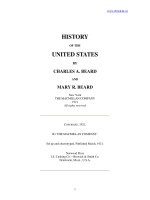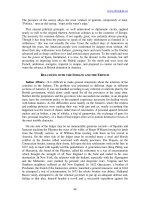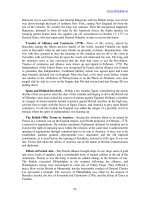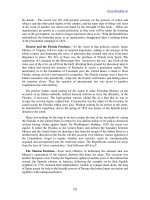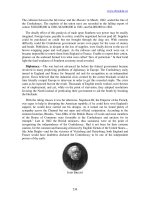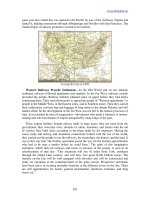Test bank for a people and a nation a history of the united states 10th edition by norton
Bạn đang xem bản rút gọn của tài liệu. Xem và tải ngay bản đầy đủ của tài liệu tại đây (304.3 KB, 24 trang )
Test Bank for A People and a Nation A History of the United States 10th Edition by Norton
Full
file at />Name:
Class:
Date:
Chapter 01: Three Old Worlds Create a New, 1492–1600
Instructions:
Identify each item. Give an explanation or description of the item. Answer the questions who,
∙
what, where, and when.
Explain the historical significance of each item. Establish the historical context in which the
item exists. Establish the item as the result of or as the cause of other factors existing in the
∙
society under study. Answer this question: What were the political, social, economic,
and/or cultural consequences of this item?
1. Paleo-Indians
ANSWER:
Answer not provided.
POINTS:
1
REFERENCES: p. 6
2. Teotihuacán
ANSWER:
Answer not provided.
POINTS:
1
REFERENCES: p. 6
3. the Mayas
ANSWER:
Answer not provided.
POINTS:
1
DIFFICULTY: p. 6-7
4. the Pueblos
ANSWER:
Answer not provided.
POINTS:
1
REFERENCES: p. 7
5. the Mississippians
ANSWER:
Answer not provided.
POINTS:
1
REFERENCES: p. 7
6. the City of the Sun (Cahokia)
ANSWER:
Answer not provided.
POINTS:
1
REFERENCES: p. 7
Powered by Cognero
Full file at />
Page 1
Test Bank for A People and a Nation A History of the United States 10th Edition by Norton
Full
file at />Name:
Class:
Date:
Chapter 01: Three Old Worlds Create a New, 1492–1600
7. Monks Mound
ANSWER:
Answer not provided.
POINTS:
1
REFERENCES: p. 7
8. The Aztecs
ANSWER:
Answer not provided.
POINTS:
1
REFERENCES: p. 8
9. Huitzilopochtli
ANSWER:
Answer not provided.
POINTS:
1
REFERENCES: p. 8
10. Tenochtilán
ANSWER:
Answer not provided.
POINTS:
1
REFERENCES: p. 8
11. Upper Guinea
ANSWER:
Answer not provided.
POINTS:
1
REFERENCES: p. 11, 13
12. Lower Guinea
ANSWER:
Answer not provided.
POINTS:
1
REFERENCES: p. 11, 13
13. dual-sex principle
ANSWER:
Answer not provided.
POINTS:
1
REFERENCES: p. 13
14. the Sandé and Poro cults
ANSWER:
Answer not provided.
POINTS:
1
REFERENCES: p. 13
Powered by Cognero
Full file at />
Page 2
Test Bank for A People and a Nation A History of the United States 10th Edition by Norton
Full
file at />Name:
Class:
Date:
Chapter 01: Three Old Worlds Create a New, 1492–1600
15. the Black Death
ANSWER:
Answer not provided.
POINTS:
1
REFERENCES: p. 15
16. the Hundred Years' War
ANSWER:
Answer not provided.
POINTS:
1
REFERENCES: p. 15-16
17. the lateen sail, the compass, the astrolabe, and the quadrant
ANSWER:
Answer not provided.
POINTS:
1
REFERENCES: p. 16
18. Ferdinand of Aragon and Isabella of Castile
ANSWER:
Answer not provided.
POINTS:
1
REFERENCES: p. 16, 18
19. movable type and the printing press
ANSWER:
Answer not provided.
POINTS:
1
REFERENCES: p. 16
20. Travels by Marco Polo
ANSWER:
Answer not provided.
POINTS:
1
REFERENCES: p. 16
21. the Mediterranean Atlantic
ANSWER:
Answer not provided.
POINTS:
1
REFERENCES: p. 16
22. the Azores, the Madeiras, and the Canaries
ANSWER:
Answer not provided.
POINTS:
1
REFERENCES: p. 16-17
Powered by Cognero
Full file at />
Page 3
Test Bank for A People and a Nation A History of the United States 10th Edition by Norton
Full
file at />Name:
Class:
Date:
Chapter 01: Three Old Worlds Create a New, 1492–1600
23. the Northeast Trades and the Westerlies
ANSWER:
Answer not provided.
POINTS:
1
REFERENCES: p. 17
24. Prince Henry the Navigator
ANSWER:
Answer not provided.
POINTS:
1
REFERENCES: p. 18
25. São Tomé
ANSWER:
Answer not provided.
POINTS:
1
REFERENCES: p. 18
26. Christopher Columbus
ANSWER:
Answer not provided.
POINTS:
1
REFERENCES: p. 18-20
27. Amerigo Vespucci
ANSWER:
Answer not provided.
POINTS:
1
REFERENCES: p. 20
28. Leif Ericsson
ANSWER:
Answer not provided.
POINTS:
1
REFERENCES: p. 20
29. John Cabot
ANSWER:
Answer not provided.
POINTS:
1
REFERENCES: p. 20, 22
30. Hernán Cortés
ANSWER:
Answer not provided.
POINTS:
1
REFERENCES: p. 22
Powered by Cognero
Full file at />
Page 4
Test Bank for A People and a Nation A History of the United States 10th Edition by Norton
Full
file at />Name:
Class:
Date:
Chapter 01: Three Old Worlds Create a New, 1492–1600
31. Malinche
ANSWER:
Answer not provided.
POINTS:
1
REFERENCES: p. 5, 23
32. the Spanish model of colonization
ANSWER:
Answer not provided.
POINTS:
1
REFERENCES: p. 22-23
33. the encomienda system
ANSWER:
Answer not provided.
POINTS:
1
REFERENCES: p. 23
34. Spanish friars
ANSWER:
Answer not provided.
POINTS:
1
REFERENCES: p.23
35. the Columbian exchange
ANSWER:
Answer not provided.
POINTS:
1
REFERENCES: p. 24
36. smallpox
ANSWER:
Answer not provided.
POINTS:
1
REFERENCES: p. 25
37. syphilis
ANSWER:
Answer not provided.
POINTS:
1
REFERENCES: p. 25
38. sugar, the horse, and tobacco
ANSWER:
Answer not provided.
POINTS:
1
REFERENCES: p. 25-26
Powered by Cognero
Full file at />
Page 5
Test Bank for A People and a Nation A History of the United States 10th Edition by Norton
Full
file at />Name:
Class:
Date:
Chapter 01: Three Old Worlds Create a New, 1492–1600
39. maize
ANSWER:
Answer not provided.
POINTS:
1
REFERENCES: p. 26-27
40. John Hawkins and Sir Francis Drake
ANSWER:
Answer not provided.
POINTS:
1
REFERENCES: p. 28
41. Richard Hakluyt
ANSWER:
Answer not provided.
POINTS:
1
REFERENCES: p. 28
42. Sir Walter Raleigh
ANSWER:
Answer not provided.
POINTS:
1
REFERENCES: p. 28
43. Roanoke
ANSWER:
Answer not provided.
POINTS:
1
REFERENCES: p. 28-29
44. A Briefe and True Report of the New Found Land of Virginia
ANSWER:
Answer not provided.
POINTS:
1
REFERENCES: p. 29
45. Which of the following were the first to cultivate food crops in the Americas?
a. European colonists in South America
b. Indians along the Atlantic seaboard of North America
c. Jesuit missionaries in southern California
d. Indians living in central Mexico
ANSWER:
d
POINTS:
1
REFERENCES: p. 6
Powered by Cognero
Full file at />
Page 6
Test Bank for A People and a Nation A History of the United States 10th Edition by Norton
Full
file at />Name:
Class:
Date:
Chapter 01: Three Old Worlds Create a New, 1492–1600
46. Which of the following was a consequence of the spread of agricultural techniques among Indian groups?
a. Cultural differences among groups of Indians disappeared.
b. Most groups began to live a more sedentary existence.
c. The various groups began to engage in almost constant warfare.
d. Political power within the various groups fell into the hands of land-owning elite.
ANSWER:
b
POINTS:
1
REFERENCES: p. 6
47. Why did the practice of settled agriculture lead to the emergence of more complex civilizations?
a. People practicing settled agriculture needed a more structured political system.
b. People with a steady supply of food were free to devote their energy to accumulating wealth, producing art,
building cities, and creating ceremonies and rituals.
c. An increase in the number of children in such societies gave rise to the educational institutions associated
with complex civilizations.
d. Property owners in such societies demanded laws and institutions that protected their property rights.
ANSWER:
b
POINTS:
1
REFERENCES: p. 6
48. What did the city-states of Mesoamerica and the urban clusters known as the Mississippian culture have in
common?
a. Each practiced a form of township democracy.
b. Each was engaged in extensive trade in the Caribbean basin.
c. Each had religious beliefs that were monotheistic.
d. Each reached the height of its power only after achieving success in agriculture.
ANSWER:
d
POINTS:
1
REFERENCES: p. 6-7
49. Which of the following best explains the differences in the means of subsistence and lifestyles that emerged among
Indian groups in the New World?
a. Disagreements over political beliefs caused groups to separate.
b. The various tribes migrated to the Americas separately and came from widely divergent cultures.
c. Different Indian groups adapted their means of subsistence and lifestyles to the environment in which they
settled.
d. Geographic barriers in the New World made interaction between different Indian tribes impossible.
ANSWER:
c
POINTS:
1
REFERENCES: p. 8
Powered by Cognero
Full file at />
Page 7
Test Bank for A People and a Nation A History of the United States 10th Edition by Norton
Full
file at />Name:
Class:
Date:
Chapter 01: Three Old Worlds Create a New, 1492–1600
50. Which of the following best explains the fact that bands of Indian hunters remained small in the area of the Great
Basin (present-day Nevada and Utah)?
a. The disease environment dramatically lowered the life expectancy of the inhabitants of the Great Basin.
b. The tribes of the Great Basin enacted laws that imposed strict limitations on the size of each band within the
tribe.
c. The inadequate supply of large game made it difficult to find food in sufficient quantity to support large
groups.
d. The practice of human sacrifice significantly reduced the population of the bands and tribes of the Great
Basin.
ANSWER:
c
POINTS:
1
REFERENCES: p. 8
51. North American Indian agricultural societies were alike in which of the following respects?
a. They all defined the extended family matrilineally.
b. The clans that made up these societies were defined patrilineally.
c. They all allocated agricultural chores to women.
d. Women were allowed to be chiefs in all these societies.
ANSWER:
a
POINTS:
1
REFERENCES: p. 9
52. The design of pre-Columbian Indian villages indicates which of the following?
a. These societies had an extensive trade network with one another.
b. Native Americans once had a common culture because there are no differences among the villages of
hunter-gatherer societies, agricultural societies, and fishing societies.
c. The design of Indian villages around a central place of worship indicates that, although widely separated, all
Indians had the same religious beliefs.
d. The defensive design of villages indicates that North American Indians fought with each other long before
the arrival of Europeans.
ANSWER:
d
POINTS:
1
REFERENCES: p. 10
Powered by Cognero
Full file at />
Page 8
Test Bank for A People and a Nation A History of the United States 10th Edition by Norton
Full
file at />Name:
Class:
Date:
Chapter 01: Three Old Worlds Create a New, 1492–1600
53. Women were most likely to hold political positions in
a. hunting tribes.
b. tribes that had no sexual division of labor.
c. nomadic tribes.
d. agricultural tribes.
ANSWER:
d
POINTS:
1
REFERENCES: p. 11
54. Which of the following is true of the Algonquians?
a. They followed the example of the Aztecs, practicing settled agriculture and living a sedentary existence.
b. They accepted women as rulers in some villages.
c. They defined the extended family patrilineally.
d. They were unique among the North American tribes in that they had no known religious beliefs.
ANSWER:
b
POINTS:
1
REFERENCES: p. 11
55. When Europeans began to colonize North America, the Indians on the continent
a. did not see themselves as one people and did not think of uniting against the invaders.
b. realized that unity against the invaders was essential to survival.
c. quickly accepted the religious ideas expressed by European missionaries.
d. recognized the importance of accepting and adopting the major characteristics of European culture.
ANSWER:
a
POINTS:
1
REFERENCES: p. 11
56. Which of the following was one of the major means of subsistence of the people living in the northernmost region of
Upper Guinea?
a. Farming
b. Animal husbandry
c. Cultivation of rice
d. The gold trade
ANSWER:
c
POINTS:
1
REFERENCES: p. 11
Powered by Cognero
Full file at />
Page 9
Test Bank for A People and a Nation A History of the United States 10th Edition by Norton
Full
file at />Name:
Class:
Date:
Chapter 01: Three Old Worlds Create a New, 1492–1600
57. In the fifteenth century, Lower Guinea and Upper Guinea differed in which of the following respects?
a. The governments of Lower Guinea were democratic; those of Upper Guinea were autocratic.
b. Women were responsible for the cultivation of rice in Lower Guinea but were the primary local traders in
Upper Guinea.
c. The peoples of Lower Guinea continued to practice traditional African religions; those of Upper Guinea were
heavily influenced by the Islamic religion.
d. Women were denied political power in Lower Guinea but held powerful political and religious positions in
Upper Guinea.
ANSWER:
c
POINTS:
1
REFERENCES: p. 11
58. Most Africans of Lower Guinea were similar to the agricultural Indians of the Americas in which of the following
respects?
a. The political systems of both consisted of hereditary rulers governing agricultural empires.
b. Both assigned agricultural tasks to men.
c. Both lived a nomadic existence.
d. The religious practices of both revolved around rituals designed to ensure a good harvest.
ANSWER:
d
POINTS:
1
REFERENCES: p. 11, 13
59. At the time of initial contact with the Europeans, Lower Guinea was characterized by
a. powerful and wealthy empires.
b. decentralized political and social authority.
c. religious disagreements between Christian rulers and the Muslim masses.
d. acceptance of and strong devotion to Islam on the part of rulers and people.
ANSWER:
b
POINTS:
1
REFERENCES: p. 13
60. The societies of West Africa were like Native American societies in which of the following respects?
a. The social systems of both were organized on the basis of the dual-sex principle.
b. The political systems of both were organized on the basis of autocratic rule.
c. In both, work assignments were organized on the basis of a sexual division of labor.
d. In both, women were allowed to hold formal political power over men.
ANSWER:
c
POINTS:
1
REFERENCES: p. 13
Powered by Cognero
Full file at />
Page 10
Test Bank for A People and a Nation A History of the United States 10th Edition by Norton
Full
file at />Name:
Class:
Date:
Chapter 01: Three Old Worlds Create a New, 1492–1600
61. The social systems of West Africa were all organized on the basis of the dual-sex principle, which meant that
a. female political and religious leaders governed the women and males ruled the men.
b. men and women were expected to have not only a sexual partner of the opposite sex but one of the same
sex as well.
c. every man could have two wives and every woman could have two husbands.
d. all individuals were believed to have both a masculine and a feminine side.
ANSWER:
a
POINTS:
1
REFERENCES: p. 13
62. Members of the Sandé cult
a. frequently engaged in wars with neighboring tribes to obtain prisoners for human sacrifice to the gods.
b. established diplomatic relations between Benin and Portugal and acted as middlemen in the trade between
the two societies.
c. were led by female religious leaders and were not allowed to reveal the secrets of their cult to men.
d. were the only known West Africans to have monotheistic religious beliefs.
ANSWER:
c
POINTS:
1
REFERENCES: p. 13
63. Fifteenth-century European, African, and Mesoamerican societies differed from most North American Indian
societies in that the former were
a. theocratic in nature.
b. hierarchical in nature.
c. egalitarian in nature.
d. patriarchal in nature.
ANSWER:
b
POINTS:
1
REFERENCES: p. 13
64. In contrast to African and Native American societies, women in European societies were
a. not allowed to engage in certain kinds of work.
b. usually denied positions of political and religious authority.
c. primarily responsible for discipline within the family.
d. equal to men in the eyes of the law.
ANSWER:
b
POINTS:
1
REFERENCES: p. 15
Powered by Cognero
Full file at />
Page 11
Test Bank for A People and a Nation A History of the United States 10th Edition by Norton
Full
file at />Name:
Class:
Date:
Chapter 01: Three Old Worlds Create a New, 1492–1600
65. As a result of the Black Death,
a. the people of Europe turned to the Christian religion for the first time.
b. it is estimated that one-third of the people of Europe died in the late fourteenth century.
c. the Angle and Saxon tribes of England were so weakened that they were easily defeated by William of
Normandy.
d. European scientists finally accepted the germ theory of disease long advanced by Arab scholars.
ANSWER:
b
POINTS:
1
REFERENCES: p. 15
66. After the Hundred Years' War, the monarchs of England and France worked to consolidate their political power.
They were aided in this effort by
a. their acceptance of the concept of constitutional monarchy.
b. a new sense of national identity among their subjects.
c. a resurgence of regional loyalties among nobles.
d. promising their subjects that they would uphold the concept of human rights.
ANSWER:
b
POINTS:
1
REFERENCES: p. 15-16
67. Marco Polo's Travels was important primarily because it convinced many Europeans
a. of the need for a defensive alliance against hostile non-European powers.
b. that direct trade by sea with China was possible.
c. of the need to Christianize China.
d. that Chinese culture was superior to European culture.
ANSWER:
b
POINTS:
1
REFERENCES: p. 16
68. The primary motive for the fifteenth- and sixteenth-century European voyages of exploration and discovery was the
desire to
a. spread Christianity around the world.
b. verify the new scholarly theory that there were undiscovered continents.
c. gain direct access to the goods of Africa and Asia.
d. establish naval control of the seas.
ANSWER:
c
POINTS:
1
REFERENCES: p. 16
Powered by Cognero
Full file at />
Page 12
Test Bank for A People and a Nation A History of the United States 10th Edition by Norton
Full
file at />Name:
Class:
Date:
Chapter 01: Three Old Worlds Create a New, 1492–1600
69. These winds made it easy for Spanish and Portuguese mariners to sail from the Iberian Peninsula to the Canary
Islands.
a. The Northeast Trades
b. The Polar Easterlies
c. The Horse Latitudes
d. The prevailing Westerlies
ANSWER:
a
POINTS:
1
REFERENCES: p. 17
70. Why was it difficult for Spanish and Portuguese mariners to return home from the Canary Islands?
a. They had to sail against the winds.
b. Unusual magnetic fields in that area rendered navigational instruments useless.
c. Berber pirates preyed on ships sailing northward from the Canaries.
d. They had no knowledge of the tacking maneuver.
ANSWER:
a
POINTS:
1
REFERENCES: p. 17
71. The Mediterranean Atlantic prepared the way for the European voyages of exploration and discovery because it
was there that European mariners
a. first learned the skill of trimming their sails.
b. discovered that the Westerlies would carry them swiftly into the Atlantic and toward the Caribbean.
c. first learned the importance of square sails in making their ships more maneuverable.
d. learned the valuable strategy of sailing around the wind.
ANSWER:
d
POINTS:
1
REFERENCES: p. 17
72. By the 1470s the world's first colonial plantation economy was found in the
a. Azores.
b. Canaries.
c. Madeiras.
d. West Indies.
ANSWER:
c
POINTS:
1
REFERENCES: p. 17
Powered by Cognero
Full file at />
Page 13
Test Bank for A People and a Nation A History of the United States 10th Edition by Norton
Full
file at />Name:
Class:
Date:
Chapter 01: Three Old Worlds Create a New, 1492–1600
73. After conquering the last Canary Island in 1496, the Spanish devoted the land to the cultivation of
a. corn.
b. rice.
c. sugar.
d. tobacco.
ANSWER:
c
POINTS:
1
REFERENCES: p. 18
74. Which of the following correctly characterizes the trade relationship between Portugal and the states of West
Africa?
a. The Portuguese merchants grew wealthy; the African chiefdoms gained little.
b. The African chiefdoms gained wealth and power; the Portuguese gained little.
c. The Portuguese merchants controlled the terms and conditions of the trade.
d. The rulers of West Africa controlled the terms and conditions of the trade.
ANSWER:
d
POINTS:
1
REFERENCES: p. 18
75. Black slavery was introduced into Europe by the
a. French.
b. Spanish.
c. English.
d. Portuguese.
ANSWER:
d
POINTS:
1
REFERENCES: p. 18
76. The first economy based primarily on the bondage of black Africans was created in
a. the Azores.
b. the Canaries.
c. the Madeiras.
d. São Tomé.
ANSWER:
d
POINTS:
1
REFERENCES: p. 18
Powered by Cognero
Full file at />
Page 14
Test Bank for A People and a Nation A History of the United States 10th Edition by Norton
Full
file at />Name:
Class:
Date:
Chapter 01: Three Old Worlds Create a New, 1492–1600
77. Based on their experiences in the islands of the Mediterranean Atlantic, the Europeans learned that they
a. would have to use European laborers if colonies were to be productive and profitable.
b. could successfully transplant their crops and livestock to exotic locations.
c. would never be able to develop a system for supplying workers to distant colonies.
d. could successfully cure the diseases they contracted in distant lands.
ANSWER:
b
POINTS:
1
REFERENCES: p. 18
78. As a result of his visit to the Portuguese colony on the Gold Coast of Africa, Columbus
a. began to understand how important rice cultivation could be in solving food shortages in his native Genoa.
b. recognized the economic potential of the slave trade.
c. acquired a hatred for abusive and exploitive labor systems.
d. learned how important it was to understand and accept the belief systems of non-Europeans.
ANSWER:
b
POINTS:
1
REFERENCES: p. 18
79. Queen Isabella decided to finance exploratory voyages, in part, because she
a. believed it would divert her subjects' attention away from Spain's domestic problems.
b. hoped profits from such voyages would help finance an expedition to wrest Jerusalem from the Muslims.
c. wanted to prevent England from colonizing Africa.
d. wanted knowledge about other world cultures.
ANSWER:
b
POINTS:
1
REFERENCES: p. 18
80. Columbus's log of his first encounter with the New World and its inhabitants reveals which of the following?
a. He wanted to profit from the land he had found by exploiting its natural resources, including its people.
b. He wanted to exterminate all Native Americans and completely destroy the cultures they had built.
c. He insisted that Europeans had come merely to observe, not to change, the cultures of the New World's
native inhabitants.
d. He believed that his primary goal should be to Christianize the native inhabitants of the land he had found.
ANSWER:
a
POINTS:
1
REFERENCES: p. 20
Powered by Cognero
Full file at />
Page 15
Test Bank for A People and a Nation A History of the United States 10th Edition by Norton
Full
file at />Name:
Class:
Date:
Chapter 01: Three Old Worlds Create a New, 1492–1600
81. The first person to publish the idea that Columbus had discovered a new continent was
a. Pedro Alvares Cabral.
b. John Cabot.
c. Amerigo Vespucci.
d. Martin Waldseemüller.
ANSWER:
c
POINTS:
1
REFERENCES: p. 20
82. Which of the following is true of John Cabot?
a. He brought back to Europe the first formal knowledge of North America's northern coastline.
b. He is credited with having found an all-water route through North America to Asia.
c. As a result of his voyages, Cabot was the first European to realize that Columbus had not reached Asia.
d. He established a settlement at Vinland, which was the first European settlement in North America.
ANSWER:
a
POINTS:
1
REFERENCES: p. 20
83. Under the encomienda system,
a. the Catholic Church established schools and hospitals in Indian villages.
b. individual conquistadors were granted tributary Indian villages from which they could collect money and
goods.
c. Spanish Jesuits undertook the task of converting Indians to the Christian faith.
d. prisoners from Spain were sent to work in New World silver mines for periods ranging from seven years to
life.
ANSWER:
b
POINTS:
1
REFERENCES: p. 23
84. Large numbers of Native Americans living in Spanish territory accepted Catholicism, in part, because
a. it was the religion of their conquerors.
b. they believed the parish priests could cure them of European diseases.
c. they believed they would be executed if they refused.
d. Catholicism seemed to promise immediate rewards in this life.
ANSWER:
a
POINTS:
1
REFERENCES: p. 23
Powered by Cognero
Full file at />
Page 16
Test Bank for A People and a Nation A History of the United States 10th Edition by Norton
Full
file at />Name:
Class:
Date:
Chapter 01: Three Old Worlds Create a New, 1492–1600
85. Which of the following was a long-term consequence of the influx of gold and silver from the New World into
Spain?
a. The Spanish government funded domestic social programs that substantially raised the standard of living of
the peasant masses.
b. Rapid inflation led to an unfavorable balance of trade and the collapse of many businesses.
c. The ready availability of investment capital at low interest rates led to the expansion and modernization of
Spanish industries.
d. The Spanish government became complacent and failed to defend the nation's interests against the
aggressive Dutch and English.
ANSWER:
b
POINTS:
1
REFERENCES: p. 24
86. The main reason for the dramatic decline of the Indian population of Hispaniola from 1492 to 1542 was the
a. Spanish decision forcibly to move the Indians to South America.
b. inhumanity of the Spanish slave system.
c. introduction of European diseases onto the island.
d. psychological devastation caused by systematic destruction of traditional Indian culture.
ANSWER:
c
POINTS:
1
REFERENCES: p. 25
87. The Lakota, Comanches, and Crows of the Great Plains were profoundly affected by the
a. introduction of the horse into North America.
b. introduction of wheat and rye into North America.
c. cultivation of tobacco.
d. introduction of settled agriculture into North America.
ANSWER:
a
POINTS:
1
REFERENCES: p. 25
88. The permanent outposts established by Europeans in North America in the early sixteenth century were initially
inhabited by people whose aim was to
a. establish permanent colonies for their respective countries.
b. establish military bases for their respective countries.
c. Christianize the Indians of North America.
d. make money by sending as many beaver pelts as possible home to Europe.
ANSWER:
d
POINTS:
1
REFERENCES: p. 26, 28
Powered by Cognero
Full file at />
Page 17
Test Bank for A People and a Nation A History of the United States 10th Edition by Norton
Full
file at />Name:
Class:
Date:
Chapter 01: Three Old Worlds Create a New, 1492–1600
89. Which of the following is true concerning trade between Indians and Europeans?
a. Such trade was beneficial only to Europeans.
b. In order to supply Europeans with much-demanded furs, some Indian bands abandoned their traditional
economies.
c. The controls imposed by some Indians on trade with Europeans created financial problems for European
trading companies.
d. Most Indian bands traded with Europeans only out of fear of reprisals if they refused.
ANSWER:
b
POINTS:
1
REFERENCES: p. 28
90. Who published translations of stories of exploratory voyages and argued in favor of English colonization of North
America?
a. John Cabot
b. Richard Hakluyt
c. John Hawkins
d. Captain John Smith
ANSWER:
b
POINTS:
1
REFERENCES: p. 28
91. Sir Walter Raleigh attempted to establish English outposts in the New World, in part, because he wanted to
a. establish tobacco plantations.
b. serve the colonies of other European nations by carrying New World products into European markets.
c. establish a haven for religious dissenters.
d. establish trade with the Indians.
ANSWER:
d
POINTS:
1
REFERENCES: p. 28-29
92. Discuss the series of Mesoamerican civilizations that eventually gave rise to the Aztec civilization, and describe the
major characteristics of Aztec culture. How did the Indian cultures that emerged in Mesoamerica differ from those
that emerged in North America? What factors caused these differences?
ANSWER:
Answer not provided.
POINTS:
1
REFERENCES: p. 6-8
Powered by Cognero
Full file at />
Page 18
Test Bank for A People and a Nation A History of the United States 10th Edition by Norton
Full
file at />Name:
Class:
Date:
Chapter 01: Three Old Worlds Create a New, 1492–1600
93. Discuss the similarities and differences among the Indian cultures of North America at the beginning of the
sixteenth century. How can the differences among these cultures be explained?
ANSWER:
Answer not provided.
POINTS:
1
REFERENCES: p. 8-11
94. Discuss the similarities and differences among the fifteenth- and sixteenth-century West African cultures. How can
the differences among these cultures be explained?
ANSWER:
Answer not provided.
POINTS:
1
REFERENCES: p. 11-13
95. Discuss the political, social, and economic characteristics of the Algonquian, Iroquoian, and Muskogean Indians in
the early sixteenth century.
ANSWER:
Answer not provided.
POINTS:
1
REFERENCES: p. 8-11
96. Discuss the similarities and differences concerning the sexual division of labor among the English, the Iroquois, and
the societies of West Africa.
ANSWER:
Answer not provided.
POINTS:
1
REFERENCES: p. 8-9, 13, 15
97. Discuss the prevailing winds of the North and South Atlantic as both a hindrance and an aid to European seafarers,
and examine the role these winds played in the European voyages of exploration and discovery.
ANSWER:
Answer not provided.
POINTS:
1
REFERENCES: p. 16-17
98. List and discuss the three key lessons of colonization learned by Europeans from their experiences in the islands of
the Mediterranean Atlantic and the African coast.
ANSWER:
Answer not provided.
POINTS:
1
REFERENCES: p. 18
99. Discuss the impact of the transfer of plants, diseases, and animals on Europe and Africa and on the Americas.
ANSWER:
Answer not provided.
POINTS:
1
REFERENCES: p. 24-26
Powered by Cognero
Full file at />
Page 19
Test Bank for A People and a Nation A History of the United States 10th Edition by Norton
Full
file at />Name:
Class:
Date:
Chapter 01: Three Old Worlds Create a New, 1492–1600
100. Discuss the goals behind Spanish colonization of the Americas, and examine the features of the Spanish model of
colonization. Did Spain attain its goals? What impact did Spanish colonization have on Spanish society and on the
civilizations that the Spanish encountered in the Americas?
ANSWER:
Answer not provided.
POINTS:
1
REFERENCES: p. 22-26
101. Discuss the first English attempt to plant a permanent settlement in North America, and explain why that attempt
failed.
ANSWER:
Answer not provided.
POINTS:
1
REFERENCES: p. 28-29
Powered by Cognero
Full file at />
Page 20
Test Bank for A People and a Nation A History of the United States 10th Edition by Norton
Full
file at />Name:
Class:
Date:
Chapter 01: Three Old Worlds Create a New, 1492–1600
Map Exercise 1-1
Use the map that follows:
102. Refer to Map Exercise 1-1. On the outline map of the Americas above and referring to an historical atlas, draw in
the boundaries for and mark the location of each of the present-day nations:
Argentina
Ecuador
Paraguay
Belize
French Guiana
Peru
Bolivia
Guatemala
Puerto Rico
Brazil
Guyana
Surinam
Chile
Haiti
United States
Colombia
Honduras
Uruguay
Costa Rica
Jamaica
Venezuela
Cuba
Mexico
Dominican Republic
Nicaragua
El Salvador
Panama
ANSWER: Answer not provided.
POINTS: 1
Powered by Cognero
Full file at />
Page 21
Test Bank for A People and a Nation A History of the United States 10th Edition by Norton
Full
file at />Name:
Class:
Date:
Chapter 01: Three Old Worlds Create a New, 1492–1600
103. Refer to Map Exercise 1-1. Mark the location of each of the following cities:
Buenos Aires
Caracas
Lima
Mexico City
Panama
Santiago
ANSWER: Answer not provided.
POINTS: 1
104. Refer to Map Exercise 1-1. Using three pens of different colors (highlight pens will work fine) and referring to an
historical atlas, mark the location of:
the Aztec Empire
the Inca Empire
the Maya Empire
ANSWER: Answer not provided.
POINTS: 1
105. Refer to Map Exercise 1-1. Referring to an historical atlas, mark the following:
the route taken by Cortés in his conquest of the Aztec Empire
the route taken by Pizarro in his conquest of the Inca Empire
ANSWER: Answer not provided.
POINTS: 1
Map Exercise 1-2
On the outline map of the world that follows and using the text as a reference, mark the following:
106. Refer to Map Exercise 1-2.
Powered by Cognero
Full file at />
Page 22
Test Bank for A People and a Nation A History of the United States 10th Edition by Norton
Full
file at />Name:
Class:
Date:
Chapter 01: Three Old Worlds Create a New, 1492–1600
Part 1
You will need five colors to complete this map exercise. (Highlight pens will work fine.)
Trade winds (Northeast and Southeast) blow from the Horse Latitudes toward the Equator. The rotation of Earth
causes these winds to blow diagonally rather than directly North or South.
Westerlies blow from the Horse Latitudes toward the polar regions. The diagonal deflection of these winds is also
caused by Earth's rotation.
Stagnant air exists in the Horse Latitudes and in the area called the Doldrums. (The Horse Latitudes are so named
because the Spanish, who frequently ferried horses across the Atlantic, often found their sailing vessels stalled in
this region. As a result, they ran out of water for the horses. As the horses died from thirst, they had to be thrown
overboard.)
Polar Easterlies blow from the Arctic regions toward the more temperate regions to the South.
Use one color to highlight the area in which the Doldrums are located. Label this area "The Doldrums." (The
Doldrums are located to the immediate north and south of the Equator, where the Northeast Trades and the
Southeast Trades meet.)
Use a second color to highlight the Trade winds, both Northeast and Southeast.
Use a third color to highlight the areas in which the Horse Latitudes are located. Label this area "The Horse
Latitudes." (The Horse Latitudes are located about at about 30 degrees North latitude in the area between the
Westerlies and the Northeast Trades and at about 35 degrees South latitude (in the area between the Southeast
Trades and the Westerlies).)
Use a fourth color to highlight the Westerlies.
Use a fifth color to highlight the Polar Easterlies.
Part 2
On the outline map of the world above and using the text as a reference, mark the following:
∙
∙
∙
The route of Columbus's first voyage to the New World.
The route of Cabot's 1497 voyage to the New World.
The route of Cabot's 1498 voyage to the New World.
Part 3
Based on this map exercise, and using your text as a reference, answer the following questions:
1.
2.
3.
What winds aided Columbus in his voyage from Spain to the New World?
What winds appear to have hindered Cabot on his first voyage from England to the New
World?
What winds appear to have made Cabot's second voyage easier?
ANSWER: Answer not provided.
Powered by Cognero
Full file at />
Page 23
Test Bank for A People and a Nation A History of the United States 10th Edition by Norton
Full
file at />Name:
Class:
Date:
Chapter 01: Three Old Worlds Create a New, 1492–1600
POINTS: 1
Powered by Cognero
Full file at />
Page 24



